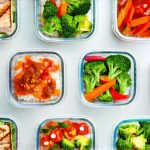Meal Preparation With Urinary Recovery in Mind
Urinary recovery – the body’s ability to efficiently eliminate waste products through urination – is often overlooked when we think about overall health and wellbeing. We frequently focus on digestive health, cardiovascular function, or mental clarity, but a healthy urinary system is crucial for removing toxins, maintaining fluid balance, and supporting kidney function. What many don’t realize is that dietary choices play an enormous role in how effectively our bodies can achieve this. Preparing meals with conscious attention to urinary recovery isn’t about restrictive diets or complicated recipes; it’s about making informed food selections and adopting simple cooking techniques that support optimal hydration, kidney health, and balanced electrolyte levels. It’s a proactive approach to wellness that empowers you to take control of your body’s natural detoxification processes.
This article explores how thoughtful meal preparation can significantly contribute to urinary recovery. We will delve into specific nutritional considerations, helpful food choices, and practical strategies for incorporating these elements into your everyday cooking routine. The focus is on building sustainable habits that prioritize a healthy urinary system – one that effectively supports overall health, vitality, and resilience. It’s about understanding the powerful connection between what we eat and how well our bodies function, not just today, but long-term. This isn’t merely about avoiding problem foods; it’s about actively nourishing your body to promote optimal urinary health. For those looking to further refine their approach, exploring low-sodium meal planning can be incredibly beneficial.
Hydration & Electrolyte Balance
Adequate hydration is the cornerstone of urinary recovery. Water flushes out waste products, prevents kidney stone formation, and supports overall kidney function. However, simply drinking enough water isn’t always sufficient; the type of fluids we consume matters just as much. Sugary drinks, excessive caffeine, and even large amounts of alcohol can actually dehydrate you and put additional strain on your kidneys. Aim for primarily plain water throughout the day – a good starting point is around eight 8-ounce glasses, but individual needs vary based on activity level, climate, and overall health. Infusing water with fruits like cucumber, berries, or citrus slices can make it more appealing and encourage greater intake.
Beyond water, electrolytes are vital for maintaining fluid balance and supporting proper kidney function. Sodium, potassium, magnesium, and calcium all play critical roles in regulating urine production and preventing imbalances. While excessive sodium is often cautioned against, completely eliminating it isn’t healthy; the key is moderation and balancing it with electrolyte-rich foods. Foods like bananas (potassium), leafy greens (magnesium), yogurt (calcium), and even small amounts of sea salt can contribute to a healthy electrolyte balance. Consider incorporating naturally salty options into your meals – think olives, pickles, or lightly salted nuts – rather than relying on processed snacks. To understand the interplay between hydration and specific dietary choices, consider hydration meal pairings.
Electrolyte imbalances can significantly impact urinary function, leading to issues like frequent urination, dehydration, or kidney problems. Therefore, focusing on a diet rich in whole, unprocessed foods is crucial for maintaining this delicate balance. Preparing meals that naturally incorporate these electrolytes—a spinach salad with sliced bananas and a sprinkle of pumpkin seeds, for example—is far more effective than simply relying on electrolyte drinks, which often contain added sugars and artificial ingredients. Prioritizing real food sources ensures your body receives the nutrients it needs in their most bioavailable form. Learning how to establish daily patterns can reinforce these healthy habits.
Incorporating Kidney-Friendly Foods
Kidney health is inextricably linked to urinary recovery. Supporting kidney function through diet can help prevent complications and maintain optimal waste elimination. Foods low in oxalate, phosphorus, and potassium are generally recommended for individuals with existing kidney issues or those looking to proactively support their renal health. However, even without pre-existing conditions, incorporating these principles into meal preparation is a smart choice. This doesn’t mean eliminating entire food groups; it means making informed substitutions and being mindful of portion sizes.
Consider swapping out high-oxalate foods like spinach (in large quantities), rhubarb, and chocolate for lower-oxalate alternatives such as cauliflower, cabbage, or green beans. Reducing phosphorus intake can be achieved by limiting processed foods, dark colas, and dairy products (or choosing low-phosphorus options). Potassium levels can be managed through careful portion control of high-potassium fruits like bananas and oranges, opting instead for apples, grapes, or berries in moderation. It’s important to remember that dietary recommendations should always be personalized based on individual needs and health conditions. Those with specific concerns might benefit from kidney-supportive meal plans.
Meal planning becomes particularly helpful when focusing on kidney-friendly foods. By proactively preparing meals with these considerations in mind, you can avoid impulsive choices that might strain your kidneys. This could involve batch cooking large portions of roasted vegetables (cauliflower, cabbage), making soups with low-oxalate ingredients, or prepping snacks like apple slices with almond butter instead of processed chips. The goal is to make healthy choices convenient and accessible, reducing the temptation to opt for less kidney-friendly options.
Flavor Without Excessive Sodium
Many people associate flavorful food with excessive salt. However, it’s entirely possible – and often more beneficial – to create delicious meals without relying heavily on sodium. Herbs and spices are your best friends here! Experimenting with different combinations of seasonings can unlock a world of flavor and reduce the need for added salt. Think about using garlic, ginger, turmeric, cumin, paprika, or chili powder to enhance the taste of your dishes. Fresh herbs like basil, oregano, rosemary, and thyme also add depth and complexity without contributing to sodium intake.
Beyond herbs and spices, other techniques can boost flavor naturally. Roasting vegetables brings out their inherent sweetness, while marinating meats in citrus juice or vinegar adds tanginess and tenderness. Using a splash of lemon juice or balsamic vinegar can brighten up salads and sauces. Even incorporating small amounts of fermented foods like sauerkraut or kimchi (in moderation) can add umami richness without relying on salt. The key is to think creatively about how you can enhance flavors using natural ingredients. A deeper understanding of nutritional balance can be found by exploring macro nutrient balancing.
When cooking, consider adding salt at the very end of the process. This allows you to use less overall because your taste buds are more sensitive at the beginning of cooking. Additionally, reading food labels carefully and choosing low-sodium options whenever possible is essential. Don’t be afraid to experiment with different flavor combinations – you might be surprised by how delicious and satisfying a low-sodium diet can be. Remember that adapting to less salt takes time, but your taste buds will eventually adjust.
Meal Prep Strategies for Success
Successful meal preparation for urinary recovery isn’t about drastic changes overnight; it’s about building sustainable habits. Start small – perhaps by prepping just one or two meals a week. Gradually increase the number of prepared meals as you become more comfortable with the process. Planning is paramount. Take some time each week to plan your meals, create a grocery list based on kidney-friendly and low-sodium recipes, and schedule dedicated prep time.
Batch cooking can save significant time and effort. Preparing large quantities of grains (quinoa, brown rice), roasted vegetables, or lean protein sources (chicken breast, fish) allows you to quickly assemble healthy meals throughout the week. Portioning out these ingredients into individual containers makes it even easier to grab-and-go during busy times. Consider using reusable containers and labeling them clearly with the date and contents.
Finally, don’t be afraid to repurpose leftovers! Roasted chicken can become part of a salad or added to soup. Leftover vegetables can be used in omelets or stir-fries. Repurposing leftovers minimizes food waste and simplifies meal preparation. For those seeking even more comprehensive guidance, balanced meal plans offer a structured approach.





















